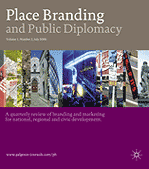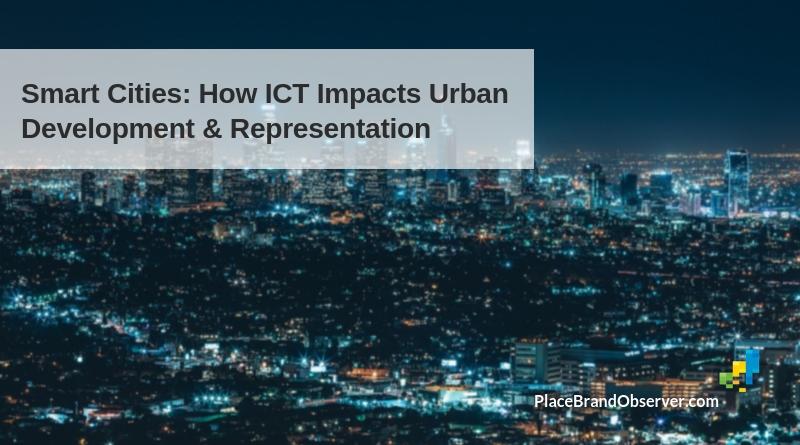“Smart city” is one of those buzzwords increasingly also used in city branding. It’s not always clear, however, what the term refers to. Is being “smart” about being sustainable, or just tech-savvy?
We caught up with Olga Kolotouchkina, Associate Professor at CEU San Pablo University in Madrid, and Gildo Seisdedos, Professor at IE Business School, Madrid, who recently shared their research insights into “place branding strategies in the context of new smart cities: Songdo IBD, Masdar and Skolkovo” with readers of the academic journal Place Branding and Public Diplomacy.
Why do cities want to be “smart” – and what does “smart city” mean?
As cities have become powerful magnets for people all over the world, urban population keeps growing steadily. While this situation might be positive for the economic wealth of urban spaces, space sharing, urban liveability as well as urban sustainability become a key challenge to address.
In this context, smart cities lead urban innovation practices in order to optimize urban flows, the supply of key services to residents, as well as their environmental impact. The range of smart initiatives implemented by cities is very broad nowadays: from sophisticated smart city platforms operating on a city level in order to measure, record, connect and manage all key urban systems, to a wide variety of specific apps optimizing anything from parking facilities to energy-saving solutions.
All these initiatives are closely linked to the advancements in the field of fibre optic, augmented and virtual reality, the Internet of Things, sensoring, the Big Data and cloud computing.
Smart technology makes cities more sustainable, manageable and predictable.
The other perspective of urban smartness relates to the ability of urban spaces to enhance the collective intelligence, creativity and inventiveness of their residents. Cities become unique labs of citizens’ entrepreneurship, social mobilization, as well as content generation and new formats of digital representation of places by residents. This social innovation is also closely linked to the technological innovation of the urban space.
How can cities involve ICT in their urban development and representation (branding)?
Digital representation of urban spaces, as well as innovative formats of urban communication, indicate the increasing reliance of cities on technological innovation, in order to strengthen their reputation and global relevance as dynamic, visionary and adaptive places.
Almost all City Halls and Tourism authorities deliver their key contents, news, services and initiatives through internet portals with a significant focus on interactive communication with their multiple targets.
The presence of City Halls in all relevant social networks and digital communication channels – such as Facebook, Twitter, Instagram or YouTube – is another salient feature of this new urban digital reality.
Some Mayors have started using their personal email or even WhatsApp for regular communication with their citizens.
On the other hand, specific city apps facilitating leisure, shopping or urban transit options are becoming more frequent nowadays.
The dynamics of place research and exploration by potential and existing stakeholders, their decision-making process about the place, as well as their interaction with the city, happen increasingly within the new digital urban environment.
What impact does the “smartness” of a city have nowadays on its competitiveness and reputation?
Technology-led and inspired urbanism is becoming one of the key competitive values of the place. Being smart means efficiency, sustainability and prosperity. All these values are relevant triggers for visitors, investors and global talent.
A recent survey by Spanish Telecom Telefonica found that 70% of Internet users consider that a technologically advanced city is a more attractive place to live, work and visit.
In addition, all relevant city reputation and performance rankings, such as Innovation Cities Index, European Digital Cities Index, Global Power Cities Index or City RepTrak include the dimensions of R&D, Technological and /or Digital Innovation and Digital Economy in their equations of the most advanced and powerful cities.
Which are the most salient features of the place branding strategies of new smart cities, such as Songdo International Business District (Songdo IBD) City in South Korea, Masdar City in Abu Dhabi or Skolkovo City in Russia?
The three cities covered by our research are entire new cities built following smart principles. We were particularly interested in reviewing these cases due to their singularity as smart city labs.
Among their most salient features, the first one to point out is the mixed public-private ownership: all cities were built by and for leading technological companies. These IT companies involved in the urban development, together with other IT companies which relocated to these cities, are their key ambassadors nowadays, contributing to visibility and relevance of each urban project.
This co-branding approach between a city and its resident business companies is a remarkable feature of the three projects, evidencing a clear commercial and business logic as a key driver of these smart city developments.
Another aspect worth considering in this context is the monolithic visual identity developed in the cases of Skolkovo and Masdar city under the corporate umbrella of their developers, large public and private companies.
The boundaries between business and urban projects are blurred and these cities are perceived more as sub-brands of a large holding than unique and authentic cities that they claim they are.
The second salient feature of the three cities is their focus on the attraction of highly skilled and talented residents. This target includes mainly employees of multinational companies, technological start-ups owners, researchers and graduate students who are offered a wide range of taxation incentives and subsidies to facilitate their transfer to these smart environments.
Also related to the residents’ profile issue, is the situation with housing and accommodation options available at these cities. Housing facilities with the most innovative solutions are provided there, however only Songdo IBD offers both property ownership and rental options.
In the case of Skolkovo and Masdar, residents cannot become property owners, only rental is available for them. These new smart cities therefore are built as attractive environments for highly skilled residents who will not be allowed to assume their role as true citizens of the place. Their engagement with the place will always be subject to their employment period at one of the business partner companies located in the city.
How can smart city approaches help engage locals in fostering community identity?
The nature of new smart cities emerging around the world makes them extraordinary references for a close observation of place branding dynamics. The role of citizens of these places on account of their technological empowerment by ICT-led urbanism becomes particularly relevant.
The optimum combination of technology and human capital dimensions is a key challenge for these places if they aim to become truly authentic and vibrant places, stimulating knowledge spillover and sharing their best urban practices to address the challenges of the digital divide and social inequality.
Which are the main dangers and pitfalls linked to smart cities and city competitiveness, as well as reputation?
First of all, the hype of smart city tends to focus on technology, forgetting that technology is just a means to get higher levels of citizens’ satisfaction, not a goal on itself.
Technocrats might find they have a fully deployed smart city in terms of technology, but we need to connect this fact to a swift responsiveness in terms of reacting (anticipating, if possible) citizen’s demands. From this perspective, “identifying smart city with technicalities with no impact in my daily life” is a growing citizen perception that should be tackled, as it is not at all like that.
On a similar note, some smart city developments could curb “urban spontaneity” as processes and rigidity of technologic frameworks can restrain creativity and innovation.
Which topics linked to smart cities, city branding, urban sustainability and community involvement would you consider important to address in future research?
Further research focused on the assessment of citizens’ profile evolution, identifying the level of their social activism and their capacity to become true place makers could provide relevant insights into the holistic dimension and potential human scale essence of these new smart places.
From a more technological perspective, applying blockchain makes sense for cities, opening an interesting new topic for research and experimentation.
blockchain4cities ticks all the boxes: many different agents sharing information, continuous data update, information needs to be trusted (protected against manipulation and fraud), plenty of intermediaries – adding complexity to the management and fast, swift connections with many participants interacting.
The research article is available here. Smart cities and place branding: opportunities and challenges was also the focus of a recent panel session. For a summary of expert views on the topic, click here.
 About Place Branding and Public Diplomacy
About Place Branding and Public Diplomacy
Place Branding and Public Diplomacy is the first and only journal to concentrate on the practice of applying brand strategy and other marketing techniques and disciplines to the economic, social, political and cultural development of cities, regions and countries.
The Place Brand Observer has teamed up with the journal’s publishers, Springer and Palgrave Macmillan, to share with you key research insights and findings.
Enjoyed this research update on how smart cities and ICT impact urban development and representation = city branding? Spread the word!


